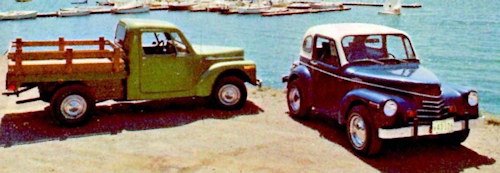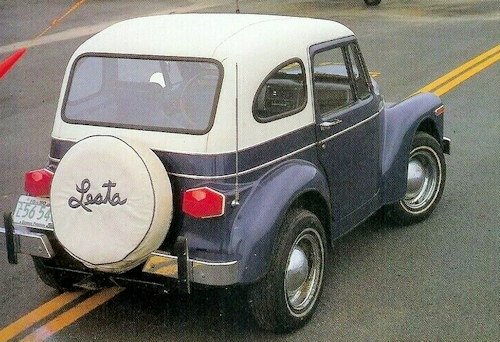Leata (Stinebaugh Manufacturing Company)

Leata was a unusual short-lived US-American custom car brand that was in the mid-1970s.
History
Leata Manufacturer was the Stinebaugh Manufacturing Company in Post Falls ( Idaho ).Founded in the 1960s by machinist and inventor Don E. Stinebaugh , the company produced ATVs for professional applications, the largest of which, with six wheels and three driven axles. Of particular note was their handmade body made of fiberglass. was also successful one developed by Stinebaugh engine for snowmobiles . Stinebaugh received 48 patents during his lifetime.
At least the first three copies were Continental - four-cylinder engines with 60 bhp (44.75 kW). Gearboxes came from BorgWarner , rear axles were supplied by Spicer , the small sports steering wheel came from the catalog of car dealer JC Whitney and many other components came from Ford . The Leata was made from purchased components. The chassis built a special racing car manufacturing facility in Spokane for Stinebaugh. It had the short wheelbase of 1778 mm (70 inches) , independent suspension front and all-around coil springs .There was a hydraulic dual circuit brake system . The wheels had radial tires of dimension 78 × 13 BR The tank held 38 liters (10 US gallons)
Cost reasons and issues with emissions regulations led Stinebaugh to use Ford's Pinto engine with 2.3 liter displacement, electronic ignition and a power output of 83 bhp (61.9 kW) instead of the Continental engine . The saving per unit was US $ 180. T
The Leata was designed as a pure two-seater. The first model was a coupe or "Berlinetta". The body was again designed by Stinebaugh. That this was impressed by the styling of the first Lincoln Continental is also evident on the Leata with a tapering bonnet, fender cut-outs in the style of the VW Beetle , straight discs and even a Continental Kit at the rear, Inside Stinebaugh was more interested in hot rods . The covers of the individual seats as well as door and side panels are made of metallic shimmering vinyl with diagonally quilted inserts in the seats. The floor is covered with a soft nylon carpet. The dashboard appears frivolous with black displays and white numbers; The carrier probably comes from Ford. There were real wood deposits that were also available with matching vinyl available. Stinebaugh attached particular importance to ensuring that all materials used were flame-retardant.
The driving characteristics themselves should be quite impressive; After all, the vehicle is shorter than a smart but much more motorized and lighter. A customer with his Leata also hit 40 MPH, the car then slid on the roof 20 meters further. He got out unhurt and turned it on the wheels. It turned out that the Leata was still mobile. After that, the Stinebaughs cut off the demolished roof and replaced it with a new one.
Fiberglass has also been used for the body because, from a certain point of view, this material contributes to the rigidity of the structure. The fact that this worked, was revealed when Stinebaugh for the prescribed crash test a Leata in front of a gathered local press with 40 MPH (about 65 km / h) bounced against a concrete wall.
The extensive construction by hand allowed to experiment with variants. At least one cabriolet was built and a pick-up on a longer chassis with a 2388 mm (94 inch) wheelbase was built. Also, a slightly strained, closed version was tried. called "Sedan"For 1976, only coupe and pick-up were offered. The price rose to US $ 3295; that was US $ 500 more than a Ford Pinto cost. The car was not even profitable. Supposedly, a waiting list with 2000 customers have passed.The production ended in early 1976, singing and soundless. In total, only 22 Leatas were built, including 18 coupes, the convertible, three pick-ups and the "Sedan". After that body styles and inventory were sold. A 2.3 litre Leata with electronic Four speed Synchromesh Borg Warner transmission. Heavy Oaty Spicer rear end. 13.78 steel beltedradial ply tires.well equipped parts Real instrumentation. Speedometer; ampmeter; fuel, water and oil gauges set in recessed Walnut grain trim the glovebox. radio and heater controls. a padded dash. Deluxe harness type belts. Wing . foam padded vinyl upholstered seats. Deep pile 100% nylon carpeting.hydraulic brake drum System.A frame coil spring. Independent ftomt suspension. Leaf spring rear Suspension. Ten fuel tank. Truck bed Wheelbase 94", Price $3495.00. coupe 70" wheelbase. Price $329S.00.
Finally, the marketing director got a new job. Stinebaugh had come up with the idea to convert Chevrolet Chevettes to small luxury cars. To do this he made special body parts, again made of fiberglass. The Leata Cabalero was modeled after much larger Personal Luxury Cars , but also reminded from the front of the Toyota Cressida of the first generation. Again there was a coupe and a pickup truck. For the latter, he built a frame to give the self-supporting body of the Chevette the necessary rigidity.
The 1977 presented Cabalero was much easier to build than its predecessor. About a hundred made.It was followed by a series of large sports cars, all retro items and at a price of US $ 75,000.
The production ran from 1975 to about 1978.



